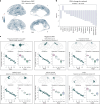Neuroanatomical changes observed over the course of a human pregnancy
- PMID: 39284962
- PMCID: PMC11537970
- DOI: 10.1038/s41593-024-01741-0
Neuroanatomical changes observed over the course of a human pregnancy
Abstract
Pregnancy is a period of profound hormonal and physiological changes experienced by millions of women annually, yet the neural changes unfolding in the maternal brain throughout gestation are not well studied in humans. Leveraging precision imaging, we mapped neuroanatomical changes in an individual from preconception through 2 years postpartum. Pronounced decreases in gray matter volume and cortical thickness were evident across the brain, standing in contrast to increases in white matter microstructural integrity, ventricle volume and cerebrospinal fluid, with few regions untouched by the transition to motherhood. This dataset serves as a comprehensive map of the human brain across gestation, providing an open-access resource for the brain imaging community to further explore and understand the maternal brain.
© 2024. The Author(s).
Conflict of interest statement
The authors declare no competing interests.
Figures




Update of
-
Neuroanatomical changes observed over the course of a human pregnancy.bioRxiv [Preprint]. 2024 May 10:2023.12.14.571688. doi: 10.1101/2023.12.14.571688. bioRxiv. 2024. Update in: Nat Neurosci. 2024 Nov;27(11):2253-2260. doi: 10.1038/s41593-024-01741-0. PMID: 38168195 Free PMC article. Updated. Preprint.
References
-
- World Health Organization. Maternal, newborn, child and adolescent health and ageing. platform.who.int/data/maternal-newborn-child-adolescent-ageing (2022).
-
- Thornburg, K. L., Bagby, S. P. & Giraud, G. D. Knobil and Neill’s Physiology of Reproduction pp. 1927–1955 (Elsevier, 2015).
-
- Brunton, P. J. & Russell, J. A. The expectant brain: adapting for motherhood. Nat. Rev. Neurosci.9, 11–25 (2008). - PubMed
-
- Gregg, C. Pregnancy, prolactin and white matter regeneration. J. Neurol. Sci.285, 22–27 (2009). - PubMed
-
- Haim, A. et al. A survey of neuroimmune changes in pregnant and postpartum female rats. Brain Behav. Immun.59, 67–78 (2017). - PubMed
MeSH terms
Grants and funding
- ZIAMH002783/U.S. Department of Health & Human Services | NIH | National Institute of Mental Health (NIMH)
- ZIA MH002783/ImNIH/Intramural NIH HHS/United States
- F99 AG079790/AG/NIA NIH HHS/United States
- NIH T32 AG00096-40/U.S. Department of Health & Human Services | NIH | National Institute on Aging (U.S. National Institute on Aging)
- F99AG07979/U.S. Department of Health & Human Services | NIH | National Institute on Aging (U.S. National Institute on Aging)

